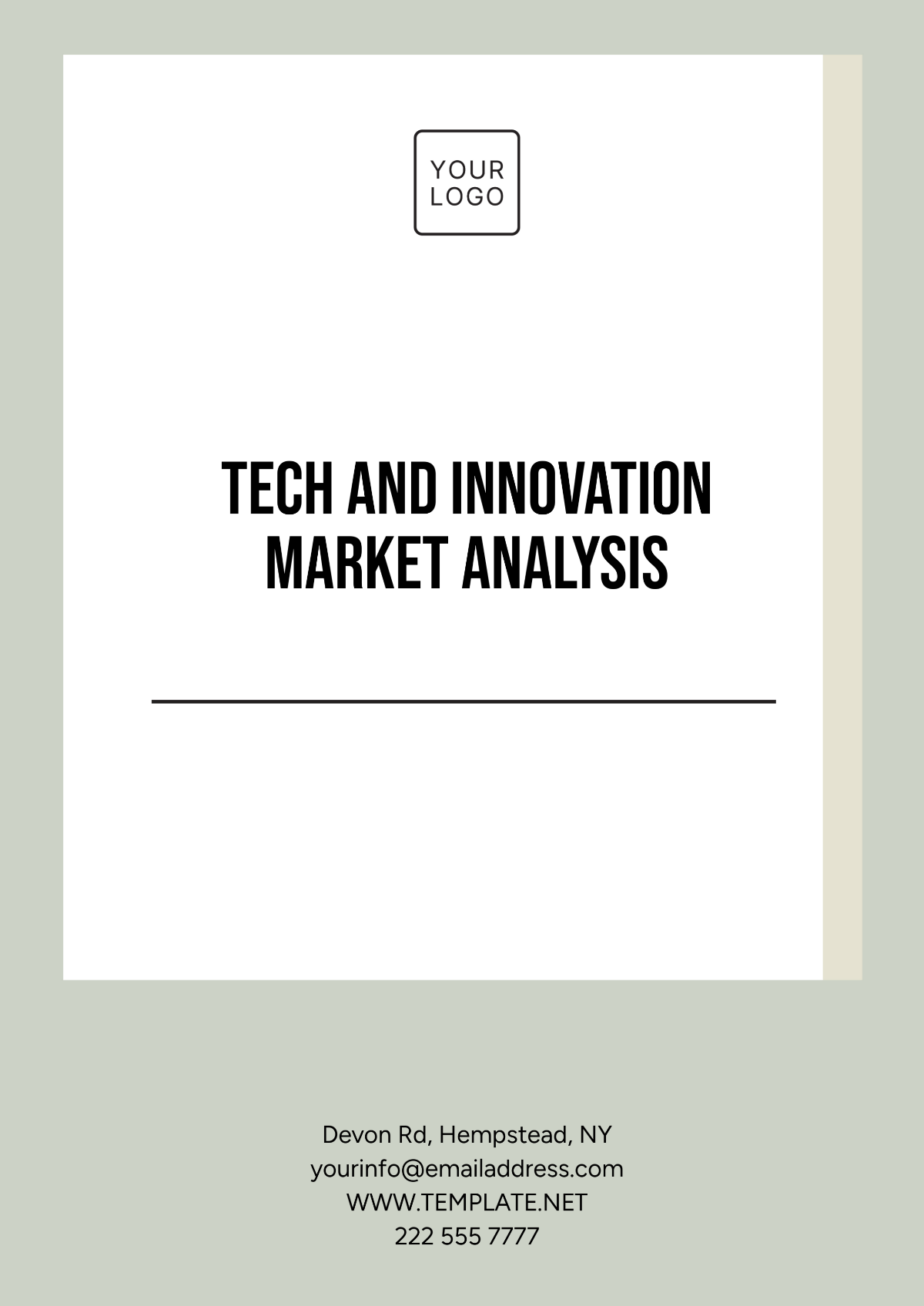Marketing Comprehensive Market Analysis
I. Market Overview
[Your Company Name] presents the Market Overview for the Electronics Industry. Our aim is to provide marketing professionals with a clear understanding of the dynamics within this market. In 2053, this market is valued at $1.2 trillion, showing steady growth of 5% over the past five years. Key players in the market include Apple Inc., Samsung Electronics, and Sony Corporation, dominating 45% of the total market share.
The Electronics Industry exhibits a promising landscape for marketing endeavors, with an increasing focus on sustainable and eco-friendly products, as well as the rapid adoption of 5G technology. As marketing professionals, it's crucial to explore this market thoroughly to identify opportunities and challenges that can inform effective strategies for [Your Company Name] in the coming year.
II. Market Segmentation
[Your Company Name] has conducted a demographic segmentation analysis to better understand our target market within the Electronics Industry. We've created a bar graph that visualizes key demographic segments:
III. Competitive Analysis
Understanding the competitive landscape within the Electronics Industry is paramount for [Your Company Name] to position itself effectively. Our comprehensive competitive analysis delves into the key players and their market strategies, enabling us to identify opportunities and threats.
Competitor | Market Share | Strengths | Weaknesses | Strategies |
Orange Inc. | 20% | Strong brand | Premium pricing | Focus on ecosystem integration, new product launches |
JBY Electronics | 18% | Diverse product portfolio | Intense competition | Innovation, cost leadership |
Lory Corporation | 10% | Strong reputation | Declining market share in some segments | Focus on gaming, entertainment, and emerging technologies |
IV. Customer Profiles
In order to create targeted marketing campaigns, it's essential for [Your Company Name] to have a deep understanding of our potential customers within the Electronics Industry. By crafting detailed customer profiles, we can effectively tailor our products, messaging, and distribution channels to meet their specific needs. Here are some key customer segments:
Customer Segment | Demographics | Behavior | Needs |
Tech Enthusiasts | Mostly millennials and Gen Z | Early adopters, seek the latest technology | Cutting-edge features, high-performance devices |
Budget Shoppers | Diverse age groups | Price-sensitive, value-driven | Affordable options, good quality |
Professionals on the Go | Working professionals | Seek productivity tools, portable devices | Long battery life, lightweight products |
Eco-Conscious Consumers | Varied age groups | Prioritize sustainability and eco-friendliness | Energy-efficient devices, recyclable materials |
Gaming Enthusiasts | Diverse age groups, skewed towards younger demographics | Passionate about gaming, high-performance requirements | Gaming peripherals, high-refresh-rate displays |
Home Entertainment Seekers | Families, individuals | Look for home theater and entertainment solutions | High-quality audiovisual equipment, smart home integration |
V. Market Trends
Staying attuned to the latest market trends is essential for [Your Company Name] to maintain a competitive edge in the Electronics Industry. Here are some noteworthy trends shaping the market landscape:
|
|
VI. SWOT Analysis
A SWOT analysis is essential for [Your Company Name] to assess its internal strengths and weaknesses and the external opportunities and threats within the Electronics Industry.
Aspect | Description |
Strengths |
|
Weaknesses |
|
Opportunities |
|
Threats |
|
VII. Market Entry Barriers
Entering the Electronics Industry involves navigating various barriers and challenges that [Your Company Name] needs to consider as part of its market entry strategy. Understanding these barriers is crucial for making informed decisions. Here are the key market entry barriers:
High Capital Requirements | Establishing a presence in the Electronics Industry demands substantial investments in research and development, production facilities, and marketing. |
Intense Competition | The industry is saturated with well-established players, making it difficult for newcomers to gain market share and visibility. |
Technological Advancements | The rapid pace of technological innovation requires continuous investment to stay competitive and relevant. |
Regulatory Compliance | Adherence to stringent regulations related to product safety, environmental standards, and intellectual property protection can be complex and costly. |
Supply Chain Challenges | Managing a complex global supply chain, including sourcing components and managing logistics, can pose logistical and operational challenges. |
Brand Recognition | Building brand recognition and trust in a competitive market requires time and resources. |
Distribution Network | Establishing an effective distribution network to reach customers efficiently is essential but may require significant effort. |
Global Economic Factors | Economic downturns, currency fluctuations, and trade tensions can impact profitability and market stability. |
Cultural and Language Barriers | Entering international markets involves dealing with diverse cultures and languages, which can be a barrier to effective communication and market penetration. |
Intellectual Property Protection | Protecting intellectual property rights is critical in the Electronics Industry to prevent counterfeiting and intellectual property theft. |
Understanding and addressing these market entry barriers will be pivotal for [Your Company Name] as it develops its market entry strategy within the Electronics Industry. It will require careful planning, resource allocation, and risk management to navigate these challenges successfully.
VIII. Regulatory Environment
Navigating the regulatory landscape is a crucial aspect of operating in the Electronics Industry. Compliance with relevant laws and standards is essential for [Your Company Name] to ensure legal and ethical business practices. Here are some key regulatory considerations:
Product Safety Regulations Ensuring that electronics products meet safety standards and certifications, such as UL or CE, to guarantee consumer protection and avoid product recalls. |
Environmental Regulations Compliance with environmental laws, including regulations on e-waste disposal, energy efficiency standards, and materials restrictions (e.g., RoHS and REACH). |
Intellectual Property Protection Safeguarding your intellectual property through patents, trademarks, and copyrights to prevent infringement and protect your innovations. |
Data Privacy and Security Adhering to data protection regulations (e.g., GDPR in Europe) when collecting and processing customer data, especially for IoT and smart devices. |
Trade Regulations Complying with import/export regulations, including tariffs and trade agreements, which can significantly impact international operations. |
Labor Laws Ensuring fair labor practices and compliance with employment laws, including regulations on working conditions and wages. |
Consumer Protection Laws Adhering to regulations governing warranties, returns, and consumer rights to maintain customer trust. |
Advertising and Marketing Regulations Complying with advertising standards and regulations to ensure truthful and transparent marketing practices. |
Ethical Sourcing Upholding ethical sourcing and supply chain practices, including responsible procurement of materials and labor practices. |
Export Controls and Sanctions Adhering to export controls and sanctions to prevent unauthorized distribution of sensitive technology. |
Cybersecurity Regulations Adhering to cybersecurity regulations, especially if your products are IoT-connected, to protect against data breaches and cyber threats. |
Staying informed and ensuring compliance with these regulatory requirements is imperative for [Your Company Name] to operate ethically, avoid legal issues, and maintain a positive reputation within the Electronics Industry.
IX. Market Size and Growth Projections
In the ever-evolving Electronics Industry, comprehending market dynamics is paramount. This section presents an insightful overview of the current market size and growth projections. The accompanying line chart, titled "Electronics Industry Market Size and Growth Projections (in USD billions)," graphically illustrates the industry's financial trajectory over a three-year span. This visual aid allows for a quick grasp of market trends, aiding in strategic planning and decision-making for [Your Company Name] within this dynamic sector.
X. Marketing Strategies and Recommendations
Effective marketing strategies are the cornerstone of success in the Electronics Industry. [Your Company Name] has formulated a comprehensive set of strategies and recommendations to drive growth, enhance brand recognition, and capitalize on market opportunities.
Product Diversification Expand product offerings to meet diverse consumer needs, including smart home devices, wearables, and sustainable electronics. |
Digital Marketing Excellence Leverage digital channels, including social media, content marketing, and online advertising, to reach a wider audience and engage effectively. |
Digital Marketing Excellence Leverage digital channels, including social media, content marketing, and online advertising, to reach a wider audience and engage effectively. |
Innovation and R&D Continuously invest in research and development to stay at the forefront of technological advancements. |
Sustainability Initiatives Develop eco-friendly and energy-efficient products to align with consumer demand for sustainable electronics. |
These strategies, collectively, form a roadmap for [Your Company Name] to excel within the Electronics Industry. By implementing these recommendations and adapting to the evolving market landscape, we can drive growth, innovation, and customer satisfaction while solidifying our position as a leader in the industry.
Marketing Templates @ Template.net

















































